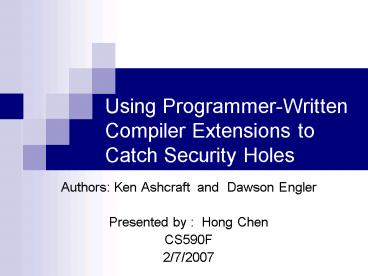Using ProgrammerWritten Compiler Extensions to Catch Security Holes - PowerPoint PPT Presentation
Title:
Using ProgrammerWritten Compiler Extensions to Catch Security Holes
Description:
Using Programmer-Written Compiler Extensions to Catch Security Holes ... Propagate the knowledge of one programmer to many. Security rules are subtle ... – PowerPoint PPT presentation
Number of Views:60
Avg rating:3.0/5.0
Title: Using ProgrammerWritten Compiler Extensions to Catch Security Holes
1
Using Programmer-Written Compiler Extensions to
Catch Security Holes
- Authors Ken Ashcraft and Dawson Engler
- Presented by Hong Chen
- CS590F
- 2/7/2007
2
Outline
- Motivation
- Example Range Checker
- Solution Details
- Belief Inference
- Analysis Issues
- Enforcing Obscure Rules
- Evaluation
- Discussion
3
Motivation (1)
- Problem
- Find security holes (security rules violation) in
source code of system software - Security rules
- Sanitize untrusted input before using it
- Do not release sensitive data to unauthorized
users - Observation
- Many rules are poorly understood and erratically
obeyed - Approach
- Use static analysis to check if security rules
are obeyed
4
Motivation (2)
- Program analysis Intuition ? Tool
- Security rules
- Domain specific
- System specific
- High-level
- Metacompilation
- Make it easy for programmer to add rules
5
Example Range Checker (1)
- Security rule
- Integers supplied by untrustworthy sources should
be range-checked before used for dangerous
operations
6
Range Check (2)
- Checker needs to identify
- Untrustworthy sources that generate data
- Checks must be done to sanitize the data
- Trusting sinks that must be protected
- Untrustworthy sources
- System calls (sys_)
- Routines copy data from user space
(copy_from_user, copyin) - Data from network
7
Range Check (3)
- Sanitizing data
- Signed integers lower and upper bound
- Unsigned integers upper bound check
- Tricky integer overflow
8
Range Check (4)
- Trusting sinks
- Array index
- Loop bound
- Copying/allocation
- routines
Potentially 3 x 3 x 3 27 types of security
holes!
9
Implementation (1)
10
Implementation (2)
- State machine representation
- Metal high-level, state-machine language
- Compilation extension linked to xgcc
- States can be global or bound to expressions
- How it works?
- After xgcc translates each input function into
its internal representation, the checker is
applied down every possible execution path in
that function
11
Implementation (3)
12
Advantages
- Propagate the knowledge of one programmer to many
- Security rules are subtle
- Find difficult-to-observe errors
- Catch error without running code
- Many errors are found in the drivers
- Lightweight
13
About the checker
- Ad hoc knowledge (security rules)
- Effective (range checker finds 100 errors in
Linux) - False negative
- False positive
14
Belief Inference
- Traditional checkers
- Hardwired knowledge
- MC
- Use code behavior to infer checking properties
- Inference
- Untrustworthy sources
- Trusting sinks
- Network Data
15
Driving Untrustworthy Sources
- Challenges
- There are many untrustworthy sources
- Difficult to analyze
- Use inference
- Untrustworthy input is often used in stylized ways
16
Deriving Trusting Sinks
- Normal checking sequence
- (1) OS reads data from unsafe source
- (2) Check the data
- (3) Pass it to a trusting sink
- What if (3) is missing?
- Something may be wrong
17
Network Data
- Challenge
- Network data is not trustworthy
- sk_buff holds network data
- Incoming or outgoing?
- Candidates
- If the fields were read more often than written,
the structure is incoming - If the checker sees the allocation of the
structure, its outgoing
18
Analysis Transitive Tainting
- Allow tainted variables to transitively taint
other variables
19
Analysis Inter-procedural Analysis (1)
- The user only provides the base unsafe sources
and trusting sinks - Automatically compute all procedures that
transitively produces or consumes data - Two-pass process
- First pass Emit a call graph, compute the
transitive set of functions, store calculated
sources and sinks in text files - Second pass at call sites, taint variable /
report errors - Special case function pointers
20
Analysis Inter-procedural Analysis (2)
21
Analysis False Positives
- Checker design
- First write simple checkers
- Eliminating false positives
- Common false positives
- Fancy bound checks
- Taint granularity
- Subroutine checks bounds
22
Analysis False Negatives
- First of all, false negatives are expected
- Potential improvements
- Comparison with correct value
- Other information flow channel (tainted value
stored in data structure) - Info lost during inter-procedure analysis
- Only local inference
23
Enforcing Obscure Rules (1)
- The length-field copy attack
- Signed integer must be lower and upper bound
checked
24
Enforcing Obscure Rules (2)
- Integer overflow
- Fixed size arithmetic
25
Evaluation (1) Errors Overview
- Severe erros as common as minor ones
26
Evaluation (2) Errors Overview
- Most bugs are local
- Low false positive rate
27
Evaluation (3) Results Validation
- Linux (2.4.5 2.4.12)
- Post errors to Linux Kernel
- Count unique errors
- Many resulted in kernel patch
- False result kernel developers will explain why
- Minor bugs may introduce possibility of new
bugs - OpenBSD (2.9)
- Submitted to a local BSD hacker
- All errors resulted in kernel patches
- Total kernel patches 50
28
Discussion (1)
- Core techniques
- Static analysis State Machine model, although
implementation details are not given (see
details) - Make ad hoc knowledge powerful
- Belief inference (save effort to specify
everything) - Extract information from source code presentation
29
Discussion (2)
- How to do better?
- Static analysis (other models/tools?)
- Finding errors (combine with dynamic analysis?)
- Other applications
- Finding bugs (past work)
30
- Thank you ?
31
Reference
- Using Programmer-Written Compiler Extensions to
Catch Security Holes - Ken Ashcraft and Dawson Engler
- In Proceeding of IEEE Security and Privacy
2002.































